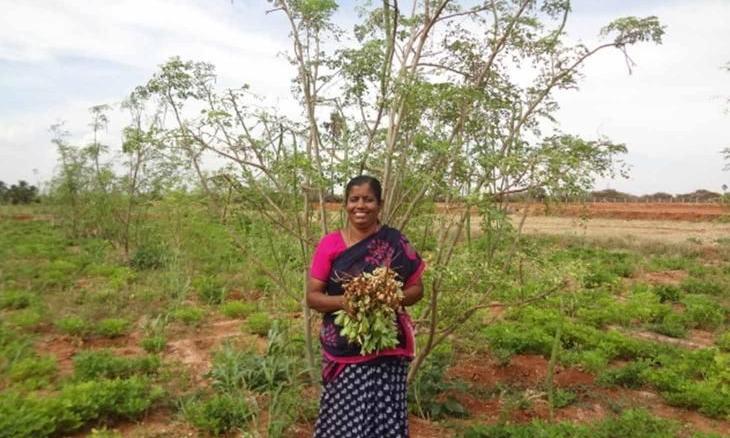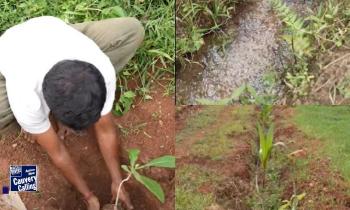Indian Farmers Would Do Well To Invest In Agroforestry
Dr. Mohit Gera reasons how agroforestry can be the key to addressing farmers' financial woes and increasing their income.

India imports 45,000 to 50,000 crore worth of wood every year. Imagine if our farmers could grow the same wood – a substantial part of the money could go to them. It can – if more farmers take to agroforestry. It makes sense in every way.
Of course, we need crop-based agriculture to feed the population; however, there are new ways of farming and new techniques and opportunities that our farmers must get access to in order to make farming a much more eco-friendly and lucrative proposition than it is right now.
If that doesn’t happen, why would anyone want to go into farming?
The woes of the average Indian farmer have been hashed several times. Suffice to say, the farmer can certainly do with a dramatic change in fortunes.
With challenges of access to working capital, monsoons playing truant and uncertain market rates, feeding the nation seems to have become one of the most thankless jobs.
Yet, the farmer diligently tills his land, grows his crop and feeds the nation. Even partially converting his farmland to follow the agroforestry model can ease his burden in many ways.
Most of India’s agricultural regions are water-stressed – this is the first hurdle for the farmer, especially if he is growing thirsty crops like sugarcane and paddy.
A kilogram of rice takes more than 5000 liters of water to grow – almost no farmer anywhere in the country can afford this kind of irrigation anymore; there simply isn’t enough water.
Apart from the fact that there are better ways to irrigate, there are better things to grow with much less water and fetch much higher market rates.
Agroforestry is also a safe bet in the longer run because the tree crop itself is a safety net for the farmer. Farmers tend to go for very short-term tree crops of 3 – 4 years because of the inbuilt uncertainty of the cultivation.
They are also not financially sound enough to cultivate, hold on to, and harvest medium to long term tree crops even if they are more lucrative because the support structure for a farmer is very weak.
Crop insurance and minimum support price for tree crops are some of the ways by which we can strengthen the support structure and mitigate the risk for farmers but more importantly there needs to be widespread awareness about the success of agroforestry in enhancing farmers’ income.
Agroforestry should be encouraged by growing native trees which may take about six to eight years to yield a harvest but they are high-value produce with guaranteed returns.
Convincing the farmer to hold out for such a long period may be a challenge; however, this can be addressed through partial conversion to agroforestry – so the cash crop and the trees complement each other and offset risks.
This is also an important avenue for institutes like the Institute of Forest Genetics & Tree Breeding, to work towards reducing the gestation period of native species so they can be harvested sooner. A high-value tree, such as Teak for timber or Melia for plywood, command good market rates.
Even in terms of labour and capital, agroforestry is a much better proposition than crop-based agriculture. It needs lesser input and yields higher returns.
And unlike crops, trees create their own fertilizer – tree foliage is the best natural fertilizer. It nourishes the soil, promotes healthy soil organisms and greatly improves the soil’s capacity to absorb and hold water.
Agroforestry is in fact being promoted actively by the government as well. In the Ganga rejuvenation project alone, more than 30 forestry interventions have been suggested that can benefit local communities.
It’s not just wood trees, even grass like bamboo, which is a highly versatile material, has great market demand. So do fruit trees and shrubs. If carefully implemented, agroforestry can be one of the best boons for Indian farmers.
Creating mini-forests also has many other benefits like revival of biodiversity, reduction of flooding and droughts and reduced instances of forest fires due to soil moisture.
With consistent and accurate messaging, it is possible to enroll farmers into agroforestry. Once they see the personal benefit, why would they not take to it? However, this will not happen overnight.
Most farmers are still very risk averse because they simply have nothing to fall back on. With some support and encouragement and with demonstrated success of agroforestry, it’s only a question of time before more farmers get on the bandwagon.
This article is part of the Cauvery Calling series . Cauvery Calling is a first of its kind campaign, setting the standard for how India’s rivers – the country’s lifelines – can be revitalised.
Dr. Mohit Gera, IFS, is the Director of the Institute of Forest Genetics & Tree Breeding. He was a Senior Fellow/Director at The Energy and Resources Institute (TERI) and was also a Member Secretary of the J&K State Pollution Control Board. Dr. Gera is an IFS officer of the J&K cadre and has published several award winning research papers in his area of expertise. He can be contacted at mohitgera87@gmail.com
Credit: This article was originally published in Swarajyamag.com











